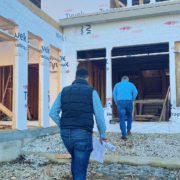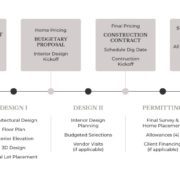A Look Ahead: What 2023 Will Look Like
 An Interview with Chris Miller
An Interview with Chris Miller
Chris Miller, owner of Miller Marriott Construction, started the design|build firm to combine two of his passions: building things and a commitment to people and community. For nearly 20 years now, he has been orchestrating the thoughtful creation of meaningful and sustainable homes and developments. Recently, Chris took time to reflect on the company’s goals and values and discuss what he foresees for Miller Marriott in 2023.
With needs evolving and a dynamic economy, how does Miller Marriott appeal to those looking to design and build a beautiful home?
We are always looking for ways to make building with Miller Marriott Construction easier for customers. For some clients, this may mean offering our whole home curation services, in which one of our talented interior designers provides selections based on the client’s unique style and inspiration.
Did anything happen in the past year that has led you to adjust the focus of your business for 2023 and beyond?
Rather than changing my focus, I would say the opposite has happened. My belief in “controlling what we can control” has been reinforced. We need to persist in our internal efforts to be great at what we do.
What are some of your goals for Miller Marriott in this next year?
This year we will be rolling out three new initiatives. All three are a result of listening to our clients and the community. The first is Oak Street Homes, which I mentioned earlier. The second is that we will introduce our Beacon Hill development in downtown Delafield. This residential development addresses the demand for new quality homes within walking distance of a desirable downtown like Delafield. Lastly, we are excited to implement Real Estate and Pre-Design client support. This service will be dedicated to our customer’s needs and provide unbiased support when clients are making decisions and weighing options on building, full home renovations, acquiring land, or valuing/selling/buying an existing home. The professionals providing this support are licensed in real estate and trained in the design-build process at Miller Marriott.
What do you think is the biggest challenge facing the industry in 2023?
A couple of challenges come to mind. One issue will be the shortage of available land on which our customers can build homes. Another challenge is cost increases imposed by differing government agencies. We are seeing these price hikes in terms of both construction and land.
You are proud of the culture at Miller Marriott. How would you describe the most important values of the company?
We truly care about our clients, which we demonstrate through respectful listening and consistent and transparent communication. We try to build every home like it is our own, with passion and thoughtfulness and close attention to each detail.
Miller Marriott was founded in 2004. What do you consider among the greatest successes along the way?
I am extremely proud of our product, our continually improving processes and our people. As a true design|build company, we are committed to great products and working closely with communities to create thoughtful solutions for local development needs. We decided a few years back that not only did we want our clients to love their home, but we also wanted them to love the process of building and working with us. Our processes focus on the client experience from when they first reach out to us to when they move in their home.
I am humbled by our growth and ultimately consider, people, the greatest success of Miller Marriott. Our staff has expanded with talented and professional individuals who holistically embrace the design and construction process. Our subcontractors and vendors are remarkable.
Ultimately, we could not have continued success without our clients. While they are all unique, I consistently find them discerning, interesting, fun and appreciative of quality design and construction. They teach us and motivate us to be our best.


 An Interview with Chris Miller
An Interview with Chris Miller


